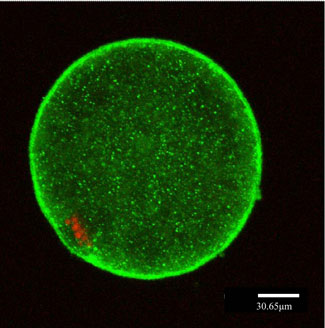In vitro fertilisation: enhancing cryopreservation

The oocytes of some mammalian species have been cryopreserved successfully through slow freezing procedures or vitrification, but rates of subsequent fertilization and embryo development are much lower than those obtained using fresh oocytes. Different studies have demonstrated that exposure of the matured oocytes to low temperatures or cryoprotectants results in the damage of meiotic spindles. Stabilizing the cytoskeleton system during vitrification could be beneficial for improving the post-thaw survival and subsequent development of vitrified oocytes. TaxolTM is a microtubule stabilizer and is currently being used as an anticancer drug. It increases the rate of polymerization by reducing the critical concentration of tubulin that is needed for polymerization. At relatively high doses, Taxol TM stabilizes microtubules by causing a tighter linkage between α and β tubulin dimmers and by enhancing microtubular cross-linking after changes in the conformation and binding of high molecular weight microtubule-associated proteins.
Our objectives were to study the effects of the TaxolTM, a cytoskeleton-stabilizing agent, on MII calf and cow oocytes with vitrification to improve post-thaw development. We evaluated the incidence of chromosome and spindle abnormalities, the cortical granule (CG) distribution of oocytes vitrified and thawed at the mature stage whether the addition of TaxolTM to the vitrification solution; and finally the embryo development after vitrification with TaxolTM.
After calf or cow oocyte vitrification without Taxol, significantly higher proportions of spindle abnormalities with dispersed or decondensed chromosomes were observed compared to fresh control oocytes. In contrast, when we compared calf oocytes pre-treated with Taxol before vitrification with control calf oocytes, similar percentages of oocytes showing normal spindle morphology were observed. The percentages of oocytes with a peripheral CG distribution increased when the oocytes were pretreated with Taxol and vitrified, while oocytes vitrified without Taxol pre-treatment gave rise to higher cortical distribution percentages. Cleavage and blastocyst rates were significantly lower for vitrified versus untreated oocytes, both in cow and calf oocytes. Significantly higher cleavage rates were obtained when calf and cow oocytes were vitrified with Taxol. Pre-treatment with Taxol before cow oocyte vitrification yielded significantly higher blastocyst rates. Calf oocytes, however, were unable to develop to the blastocyst stage, irrespective of previous Taxol treatment.
These results indicate that the pre-treatment of oocytes with Taxol before vitrification helps to reduce the damage induced by the cryopreservation process, and potentially improves the subsequent development of vitrified bovine oocytes.
References
"Effects of pre-treating in vitro-matured bovine oocytes with the cytoskeleton stabilizing agent taxol prior to vitrification" Morato, R; Izquierdo, D; Albarracin, JL; Anguita, B; Palomo, MJ; Jimenez-Macedo, AR; Paramio, MT; Mogas, T. MOLECULAR REPRODUCTION AND DEVELOPMENT, 75 (1): 191-201 JAN 2008


